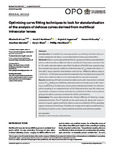Optimising curve fitting techniques to look for standardisation of the analysis of defocus curves derived from multifocal intraocular lenses
| dc.contributor.author | Law, EM | |
| dc.contributor.author | Buckhurst, Hetal | |
| dc.contributor.author | Aggarwal, RK | |
| dc.contributor.author | El‐Kasaby, H | |
| dc.contributor.author | Marsden, Jonathan | |
| dc.contributor.author | Shum, GL | |
| dc.contributor.author | Buckhurst, P | |
| dc.date.accessioned | 2022-04-28T12:53:13Z | |
| dc.date.issued | 2022-04-11 | |
| dc.identifier.issn | 0275-5408 | |
| dc.identifier.issn | 1475-1313 | |
| dc.identifier.uri | http://hdl.handle.net/10026.1/19112 | |
| dc.description.abstract |
<jats:title>Abstract</jats:title><jats:sec><jats:title>Introduction</jats:title><jats:p>To establish the most appropriate curve fitting method to allow accurate comparison of defocus curves derived from intraocular lenses (IOLs).</jats:p></jats:sec><jats:sec><jats:title>Methods</jats:title><jats:p>Defocus curves were plotted in five IOL groups (monofocal, extended depth of focus, refractive bifocal, diffractive bifocal and trifocal). Polynomial curves from 2nd to 11th order and cubic splines were fitted. Goodness of fit (GOF) was assessed using five methods: least squares, coefficient of determination (<jats:italic>R</jats:italic><jats:sup>2</jats:sup><jats:sub>adj</jats:sub>), Akaike information criteria (AIC), visual inspection and Snedecor and Cochran. Additional defocus steps at −2.25 D and −2.75 D were measured and compared to the calculated visual acuity (VA) values. Area under the defocus curve and range of focus were also compared.</jats:p></jats:sec><jats:sec><jats:title>Results</jats:title><jats:p>Goodness of fit demonstrated variable results, with more lenient methods such as <jats:italic>R</jats:italic><jats:sup>2</jats:sup><jats:sub>adj</jats:sub> leading to overfitting and conservative methods such as AIC resulting in underfitting. Furthermore, conservative methods diminished the inflection points resulting in an underestimation of VA. Polynomial of at least 8th order was required for comparison of area methods, but overfitted the EDoF and monofocal groups; the spline curve was consistent for all IOLs and methods.</jats:p></jats:sec><jats:sec><jats:title>Conclusions</jats:title><jats:p>This study demonstrates the inherent difficulty of selecting a single polynomial function. The <jats:italic>R</jats:italic><jats:sup>2</jats:sup> method can be used cautiously along with visual inspection to guard against overfitting. Spline curves are suitable for all IOLs, guarding against the issues of overfitting. Therefore, for analysis of the defocus profile of IOLs, the fitting of a spline curves is advocated and should be used wherever possible.</jats:p></jats:sec> | |
| dc.format.extent | 887-896 | |
| dc.format.medium | Print-Electronic | |
| dc.language | en | |
| dc.language.iso | eng | |
| dc.publisher | Wiley | |
| dc.subject | algorithms | |
| dc.subject | cataract extraction | |
| dc.subject | intraocular lenses | |
| dc.title | Optimising curve fitting techniques to look for standardisation of the analysis of defocus curves derived from multifocal intraocular lenses | |
| dc.type | journal-article | |
| dc.type | Journal Article | |
| dc.type | Research Support, Non-U.S. Gov't | |
| plymouth.author-url | https://www.webofscience.com/api/gateway?GWVersion=2&SrcApp=PARTNER_APP&SrcAuth=LinksAMR&KeyUT=WOS:000780134900001&DestLinkType=FullRecord&DestApp=ALL_WOS&UsrCustomerID=11bb513d99f797142bcfeffcc58ea008 | |
| plymouth.issue | 4 | |
| plymouth.volume | 42 | |
| plymouth.publication-status | Published | |
| plymouth.journal | Ophthalmic and Physiological Optics | |
| dc.identifier.doi | 10.1111/opo.12986 | |
| plymouth.organisational-group | /Plymouth | |
| plymouth.organisational-group | /Plymouth/Admin Group - REF | |
| plymouth.organisational-group | /Plymouth/Admin Group - REF/REF Admin Group - FoH | |
| plymouth.organisational-group | /Plymouth/Faculty of Health | |
| plymouth.organisational-group | /Plymouth/Faculty of Health/School of Health Professions | |
| plymouth.organisational-group | /Plymouth/REF 2021 Researchers by UoA | |
| plymouth.organisational-group | /Plymouth/REF 2021 Researchers by UoA/UoA03 Allied Health Professions, Dentistry, Nursing and Pharmacy | |
| plymouth.organisational-group | /Plymouth/Research Groups | |
| plymouth.organisational-group | /Plymouth/Research Groups/FoH - Applied Parkinson's Research | |
| plymouth.organisational-group | /Plymouth/Research Groups/Institute of Health and Community | |
| plymouth.organisational-group | /Plymouth/Users by role | |
| plymouth.organisational-group | /Plymouth/Users by role/Academics | |
| dc.publisher.place | England | |
| dcterms.dateAccepted | 2022-03-09 | |
| dc.rights.embargodate | 2022-6-7 | |
| dc.identifier.eissn | 1475-1313 | |
| dc.rights.embargoperiod | Not known | |
| rioxxterms.versionofrecord | 10.1111/opo.12986 | |
| rioxxterms.licenseref.uri | http://www.rioxx.net/licenses/all-rights-reserved | |
| rioxxterms.licenseref.startdate | 2022-04-11 | |
| rioxxterms.type | Journal Article/Review |


